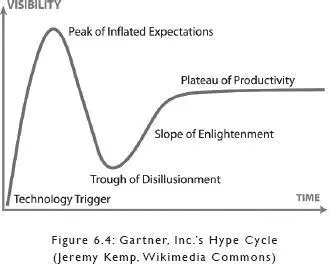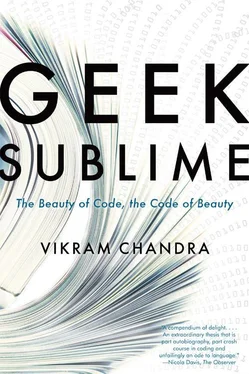In fact, adherents of Test-Driven Design (TDD) would have you write the tests before you ever write the code — that is, you write DoesMyAddTwoNumbersFunctionReallyReturnTheRightSum() before you write AddTwoNumbers(), thus forcing you to design AddTwoNumbers() to be easily testable. Usually, you write several tests for each section of code, checking for correct behavior under varying conditions, and so the lines of test code can easily outnumber the lines of program code by orders of magnitude. The open-source database SQLite, at the time of this writing, has 1,177 times the amount of test code as it does program code. 14Most non-programmers have never heard of SQLite, but it is the most widely deployed database in the world. 15SQLite is a tiny program. It runs within your Firefox browser, storing your bookmarks; it is used widely within the Mac operating system; it runs within each copy of Skype; it runs on your smartphone, storing contacts and appointments. SQLite’s vast suite of tests is an attempt to prevent bugs from creeping into a program that has become an essential, foundational component of the working memory of humanity.

Programmers work doggedly toward correctness, but the sheer size and complexity of software ensures that bugs lurk within. A bug is, of course, a flaw or fault in a program that produces unexpected results. In 1986, the award-winning researcher and academic Jon Bentley published a book that is now widely regarded as a classic, Programming Pearls. One of the algorithms he implemented was for binary search, a method of finding a value in a sorted array, which was first published in 1946. In 2006, decades after the publication of Bentley’s book — by which time his particular implementation had been copied and used many thousands of times — one of his erstwhile students, Joshua Bloch, discovered that under certain conditions this technique could manifest a bug. 16Bloch published his finding under a justly panic-raising headline, “Extra, Extra — Read All About It: Nearly All Binary Searches and Mergesorts are Broken.” He wrote:
The general lesson that I take away from this bug is humility: It is hard to write even the smallest piece of code correctly, and our whole world runs on big, complex pieces of code.
Careful design is great. Testing is great. Formal methods are great. Code reviews are great. Static analysis is great. But none of these things alone are sufficient to eliminate bugs: They will always be with us. A bug can exist for half a century despite our best efforts to exterminate it. 17
That software algorithms are now running our whole world means that software faults or errors can send us down the wrong highway, injure or kill people, and cause disasters. Every programmer is familiar with the most infamous bugs: the French Ariane 5 rocket that went off course and self-destructed forty seconds after lift-off because of an error in converting between representations of number values; the Therac-25 radiation therapy machine that reacted to a combination of operator input and a “counter overflow” by delivering doses of radiation a hundred times more intense than required, resulting in the agonizing deaths of five people and injuries to many others; the “Flash Crash” of 2010, when the Dow Jones suddenly plunged a thousand points and recovered just as suddenly, apparently as a result of automatic trading programs reacting to a single large trade.
These are the notorious bugs, but there are bugs in every piece of software that you use today. A professional “cyber warrior,” whose job it is to find and exploit bugs for the US government, recently estimated that “most of the software written in the world has a bug every three to five lines of code.” 18These bugs may not kill you, but they cause your system to freeze, they corrupt your data, and they expose your computers to hackers. The next great hope for more stable, bug-free software is functional programming, which is actually the oldest paradigm in computing — it uses the algebraic techniques of function evaluation used by the creators of the first computers. In functional programming, all computation is expressed as the evaluation of expressions; the radical simplicity of thinking about programming as only giving input to functions that produce outputs promotes legibility and predictability. There is again the same fervent proselytizing about functional programming that I remember from the early days of OOP, the same conviction that this time we’ve discovered the magic key to the kingdom. Functional languages like Clojure conjure up the clean symmetries of mathematics, and hold forth the promise of escape from all the jugaadu workarounds that turn so much code into a gunky, biological-seeming mess. In general, though, programmers are now skeptical of the notion that there’s any silver bullet for complexity. The programmer and popular blogger Steve Yegge, in his foreword to a book called The Joy of Clojure , describes the language as a “minor miracle” and “an astoundingly high-quality language … the best I’ve ever seen,” but he also notes that it is “fashionable,” and that
our industry, the global programming community, is fashion-driven to a degree that would embarrass haute couture designers from New York to Paris … Fashion dictates the programming languages people study in school, the languages employers hire for, the languages that get to be in books on shelves. A naive outsider might wonder if the quality of a language matters a little, just a teeny bit at least, but in the real world fashion trumps all. 19
In respect to programming languages and techniques, the programming industry has now been through many cycles of faith and disillusionment, and many of its members have acquired a sharp, necessary cynicism. “Hype Cycle”—a phrase coined by the analysts at Gartner, Inc. — adroitly captures the up-and-down fortunes of many a tech fad. 20

The tools and processes used to manage all this complexity engender another layer of complexity. All but the simplest programs must be written by teams of programmers, each working on a small portion of the system. Of course these people must be managed, housed, provided with equipment, but also their product — the code itself — must be distributed, shared, saved from overwriting or deletion, integrated, and tested.
Entire industries have grown around these necessities. Software tools for building software — particularly “Integrated Development Environments,” applications used to write applications — are some of the most complex programs being built today. They make the programmer’s job easier, but the programmer must learn how to use them, must educate herself in their idiosyncrasies and the workarounds for their faults. This is not a trivial task. For example, every programmer needs to use a revision control system to track changes and easily branch and merge versions of code. The best-regarded revision control system today is Git, created by Linus Torvalds (and named, incidentally, after his famous cantankerousness). 21Git’s interface is command-line driven and famously UNIX-y and complex, and for the newbie its inner workings are mysterious. In response to a blog post titled “Git Is Simpler Than You Think,” an irritated Reddit commenter remarked, “Yes, also a nuclear submarine is simpler than you think … once you learn how it works.” 22I myself made three separate attempts to learn how Git worked, gave up, was frustrated enough by other revision control systems to return, and finally had to read a 265-page book to acquire enough competence to use the thing. Git is immensely powerful and nimble, and I enjoy using it, but maneuvering it felt — at least initially — like a life achievement of sorts.
Читать дальше














